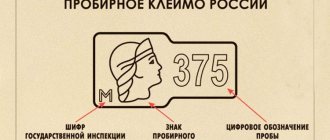In order not to make a mistake when choosing jewelry, you must be able to correctly decipher the information that is indicated on the sales tag. The situation with this issue in Russia is rather ambiguous, because there are no uniform standards regarding the description of precious stones. There is only a classification based on price lists for diamonds. Of course, this affects the market for jewelry with precious stones in the most negative way for consumers.
The lack of state standards for the quality characteristics of precious stones leads to the fact that each manufacturer or supplier indicates important information about a product with gems at its own discretion. This also leads to the fact that synthetic stones are sold under the guise of natural ones, or semi-precious stones that resemble them in appearance are passed off as precious.
What information does the tag contain?
Deciphering a tag on a piece of jewelry is not difficult. For all jewelry made of gold, silver or platinum, it must contain the following information:
- product name - ring, earrings, chain, pendant and other options;
- factory article number of decoration;
- size in the case of a ring and length for chains;
- type of precious metal - gold, platinum, silver and other jewelry alloys;
- sample (it should be on the decoration itself);
- weight in grams;
- barcode - indicates the legality of selling jewelry in a given jewelry store.
Starting from 2022, the Government of the Russian Federation is going to introduce additional mandatory labeling of jewelry. This will include applying a two-dimensional barcode to the tag. Buyers can also decipher the information from the square using a simple smartphone application. Based on the data obtained, it will be easy to understand how and from what the decoration was made.
Important! Before reading the tag on any piece of jewelry, make sure there is a seal on the “string” that secures the paper. Label sealing is a mandatory condition for the production of any jewelry in Russia.
DataMobile software for working with mandatory jewelry labeling
DataMobile Marking is specialized software for terminals and mobile devices running the Android operating system. The software is designed to automate commodity accounting operations. The software is suitable for both small retail outlets, for example, convenience stores, and for supermarkets, hypermarkets and any warehouses.
DataMobile Tagging allows:
- simplify the acceptance, release, and inventory of products;
- obtain data about a product item by parsing information encrypted in a unique tag;
- check actually received goods with those indicated in primary electronic documents using labeling codes;
- create shipping documents, register single or group Data Matrix in them;
- work with inventory forms, movement forms, write-off of marked products;
- introduce into circulation goods with unique markings, etc.
Software Benefits:
- compatibility with any commodity accounting systems, thanks to open data exchange formats;
- simple setup without programming - select parameters by ticking;
- compatibility with terminals from most manufacturers;
- expanding DataMobile functionality through free regular updates.
Free technical support is also available to software users.
The software is scalable by moving from one version to another. But even the most budget option - DataMobile Standard - makes it possible to work with marking codes and send information to the identification systems "Chestny ZNAK", GIIS DMDK and EGAIS.
DataMobile Labeling works with all categories of goods that are subject to mandatory application of unique codes within one application, that is, to trade water, jewelry and shoes at the same time, no other software is needed.
What information does the jewelry insert tag contain?
According to the domestic standard “Jewelry inserts. Information Disclosure Rules" STO 52818945-1-2016, developed by the Association "Guild of Jewelers of Russia", a certain classification of jewelry gems is used on the tags.
In the same set of rules there is a decoding of the definition of what refers to a jewelry insert - this is any cut stone made from natural or artificial materials, intended for use in jewelry. Uncut crystals only qualify as inlays if they are actually set into the jewelry.
Disclosure of information falls on the shoulders of sellers. The goal is to fully inform the buyer about the authenticity and origin of the insert. “Transfer” of information to the end consumer occurs in two ways: in writing in commercial documentation or on product labels.
According to the rules, the following information about inserts on the jewelry tag must be indicated:
- insert name;
- information about the type of refining of precious gems: the method of processing that influenced the physical and chemical properties of the stone;
- classification characteristics of a specific type of stone;
- information about the origin of the artificial insert;
- weight and number of stones in the decoration.
At the same time, the weight of natural gems is indicated in carats; the refining method has an abbreviation that is accepted throughout the world. And for artificial stones, only the name and color are allowed to be indicated (indication of the processing method is not necessary).
Marking of the type of processing of natural gems
Wondering how to correctly read a jewelry tag with a natural gemstone? Pay attention to the type of processing. It must be indicated for real gems. When there is no letter designation, you have an artificial insertion option.
Among the common and generally accepted methods of refining are:
- Trade code “B” indicates refinement by bleaching. This is the change or removal of natural shade using chemicals or physical processes, including targeted exposure to light rays.
- Coding "D" - coloring. A method of beautification for the purpose of changing color by applying paint or dyes to or within the stone. This method also includes changing the tone using the “sugar/acid” process.
- The letter "F" indicates the crack filling process. They are “filled” with a special substance or glass, resin, or plastic to obtain a smooth gem without defects, strengthening its structure.
- The designation “H” indicates heat treatment using heating in a special oven or other methods.
- The combination of the letters “HPHT” indicates the processing of the stone under high temperatures and pressure in order to change the shade of the stone.
- Trade code “I” refers to the impregnation of the gem with oil, wax, resin, polymers or plastic. The goal is to discolor the stone to replace its tone with a different one.
- The letter “L” stands for laser drilling. This is laser burning of a channel between the surface of the diamond and a dark inclusion in order to eliminate this defect or replace it with another less noticeable color.
- The Latin "O" indicates oiling, which is necessary to reduce the visibility of cracks.
- The “R” code indicates artificial irradiation to change the color of the gem.
- Trade code “U” is a variant of enhancement using diffusion to change color by heating the gem in a chemical environment.
- The Latin "W" indicates waxing - the application of colorless wax or other similar material to the surface of the stone or near-surface layer.
For example, the decoding of a diamond jewelry tag, which looks like this: “Diamond treated (HTHP) Kr 57A 3/3-1-0.25 carats,” says that the stone has undergone heat treatment and refinement using high pressure. The weight of the stone is 0.25 carats. And the numbers 3/3 indicate transparency (purity of color). Kr 57 - the number of faces in a round gem.
With the introduction of digital marking of jewelry in 2022, the tag will be much easier to read. Smartphones, using applications, will tell you everything about the place of extraction and the type of processing of the gem. They will also tell you where to buy a laser machine for marking gold and whether the sample on the metal corresponds to the real amount of gold or silver in the alloy.
Names of stones
The names of gems bring a lot of confusion to the process of identifying them and assessing their value. Often different stones bear the same ancient name due to their external similarity. There are cases when minerals are named after the place of extraction or the discoverer. Most of the long-known stones have names that explain their effect on humans.
Which stones are the most expensive and recognizable? Of course these are diamonds . The stone got its name from the Arabic word “indestructible”, as it is famous for its high strength and hardness. Another possible origin of the name is the Greek “adamas” - “irresistible”. Jewelers, depending on purity, value and size, distinguish about 1000 varieties of diamonds. Legends say that the oldest gem, Koh-i-noor, was found in India 5,000 years ago. It now adorns the crown of Britain and is kept in the English Jewelry Fund.
Sapphires are colorless, blue, yellow and even purple . For many centuries, all blue stones were called sapphire, since “sapphirus” translated from Latin means “blue”. In English, sapphire refers to all types of corundum except red and orange. Many legends note the positive influence of the gem on a person’s character. The stone gives wisdom, spiritual strength and inner harmony.
There are several options for the origin of the name topaz . According to one version, the stone was named after the island of Topazios, where it was first discovered. According to another version, topaz in Sanskrit means “fire”, “heat”. It is easy to get confused among the numerous names of the mineral. Individual names have stones of different colors or mined in a certain area. For example, blue and colorless samples are called Siberian diamonds, red ones are called Brazilian rubies. The magical influence of the stone on a person is manifested in attracting good luck, family happiness, good mood and financial well-being.
The name of many precious stones tells about the effect they have on a person. Legends say that amethyst from the Greek “amethystos” means “sobering”, “not drunk”. The mineral helps fight alcoholism and other bad habits. The old name for adularia is moonstone. It is believed that the influence of the stone on a person depends on the phases of the moon.
What to expect for pawnshops
The most controversial situation is with pawnshops. There is still a month left until the official date for submitting balances for precious metals to the GIIS DMDK, and it is not yet clear what information pawnshops should provide.
Representatives of the pawnshop market submitted requests to the Ministry of Finance of the Russian Federation and the Federal Chamber of Commerce. And... we received two different answers:
1. Chairman of the Board of RAL L.V. Gribok sent a request to the RUSSIA MINISTRY OF FINANCE. The response of the Ministry of Finance of Russia No. 22-01-06/61306 dated July 30, 2021 indicates that products that are being prepared for sale should be entered into the GIIS DMDK.
2. The executive director of the non-profit organization “NP League of Lombards” addressed the same question to the FPP. Answer No. 55-00/21/3078 dated November 19, 2021 states that pawnshops must stock all jewelry, regardless of their status (pledged, grace period, in the process of circulation).
In addition, a third option is currently being developed.
We would like to note that the functionality for pawnshop operations in the GIIS DMDK is not ready in any form at the beginning of December 2022.
production scheme in GIIS DMDK
Cycle of registration of production operations in GIIS DMDK:
1. Confirmation of the receipt of metal (scrap, return) and precious inserts from organizations that are specially registered with the FPP.
2. Entering data on the receipt of precious metal when purchasing from credit institutions (banks).
3. Sending for metal refining (if required)
4. Formation of a production boiler from refined metal
5. Registration of batches of semi-finished product with INP from the boiler for sending to the FPP.
6. Sending the batch for testing (except for silver)
7. Receipt of batches with the FPP stamp. In this case, the INP of the parties changes. (except silver)
8. Allocation of a batch of UINs for the batch that has passed testing (based on the number of branded products).
9. Registration of finished jewelry. The UIN is taken from the pool allocated for the INP during branding. Precious inserts are written off according to the INI of the parish party.
A complete production diagram of the movement of metal in production to display the accounting of GIIS DMDK can be
For better understanding, this page provides a schematic representation of the main processes from the complete production flowsheet.
Quality Control Department
The abbreviation stands for “Technical Control Department”. Some manufacturers put a quality control stamp on each product tag to prove that the stones used and the product have passed the appropriate examinations and comply with technical regulations. The stamp is not always there, and its absence does not indicate flaws in the decoration. But its presence is an additional guarantee of quality.
Be careful during the “transition” period.
From the date of provision of information on balances (01/01/2022) until the date of mandatory provision of information on turnover to GIIS DMDK (01/03/2022), a “transition” period applies.
- During this period, newly arriving products may or may not have a UIN.
- Products without UINs received from 01/01/2022 to 03/01/2022 must be marked before 04/01/2022.
- The arrival of products with already assigned UINs must be confirmed in your personal account. Even if you have not yet established accounting for UINs.
- If the arrival of products with assigned UINs is not confirmed in your personal account (within 3 days), then the UIN for these products will need to be requested and printed again. And the problem will be to understand which UINs are “burned out” and which are not. It’s sad if “burnt” UINs are discovered only during implementation.
Wholesale sales mechanism
Wholesale sales in GIIS DMDK are documented in specifications. A specification is similar to an invoice.
The specification can be created directly in the personal account of the GIIS DMDK, or downloaded with the integration configured.
Attention!!!
Signing and sending the specification created by the integration method is carried out only through your personal account.
For all legally significant actions, such as moving precious metal or precious inserts, signing the specification in your personal account is required
.
The mechanism for obtaining a specification by a legal entity has the ability to create an Act of Disagreement
. The recipient can agree with the data specified in the specification, or provide their own by filling out an act of disagreement. In this case, the specification is considered not accepted and is returned to the sender.
Attention!!!
3 business days
to confirm receipt of the specification .
During the transition period, this risks the fact that the recipient will have to request new UINs for received products and reprint the tags. What will happen if the specification is not accepted by the recipient in the personal account of GIIS DMDK within 3 days is not yet clear
.
Wholesale sales algorithm.
GIIS DMDK for Pawnshops, how to start a purchase
Purchase
Each purchase transaction must be reflected in the GIIS DMDK. A block has been added to the GIIS DMDK in which the data of an individual and information on lots in the purchase receipt are entered.
Information on purchasing in the personal account of GIIS DMDK.
Basic requirement for information systems
for correct accounting of purchases -
batch accounting of metal.
In GIIS DMDK, each line in the purchase receipt is a separate batch. The developers of GIIS DMDK announced the possibility of implementing the operation of uniting parties, but so far there is no such functionality. Note that in JewelerSoft products, batch consolidation (as well as batch accounting) has already been implemented.
Algorithm for working with purchasing
Retail sales algorithm
Let's say right away that the algorithm is hypothetical.
It was announced that before retail sale, confirmation of the transaction must be received from GIIS DMDK. The UIN of the product is sent to GIIS DMDK, GIIS checks the status of the product. If everything is normal, confirmation of sales registration is received from GIIS. Otherwise - a refusal message.
The planned mechanism for verification before sale is close in principle to the Unified State Automated Information System.
Actually, the “donor” for GIIS should be the UTM created for EGAIS. But due to departmental approvals, the transfer of the module from EGAIS to the developers of GIIS DMDK is delayed. As a result, retail sales methods have not yet been prescribed in the GIIS DMDK and the sales algorithm is only hypothetical.
Proposed retail sales algorithm.
Receipt of metal
1. All batches of metal (jewelry) are accepted in your personal account on the website in GIIS DMDK
2. The entire parish is a party parish. Each batch of metal has its own identification number.
3. If the metal is not refined, then the batches of incoming metal are combined and sent for refining
4. Batches of refined metal are the source for the formation of the production boiler.
5. Consignments of received metal are a source for registering finished products.
A simplified diagram of metal receipt for production.
Bottom line
So, on your palms lies a magnificent piece of jewelry that claims to become a family piece over time. Now you know that serious manufacturers have nothing to hide and their professional reputation is more valuable to them. Therefore, on the tag you will find information about the name and weight of the product, technical characteristics of the stones, place of their extraction and cutting, bar code and article number, legal address of the company, metal sample. If you want to learn more about the stone, you can always contact the technical control department, which, based on ownership documents, will conduct an in-depth analysis of the product.
Found a violation? Report content










